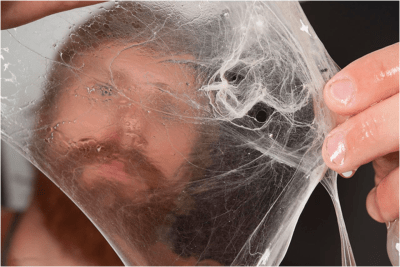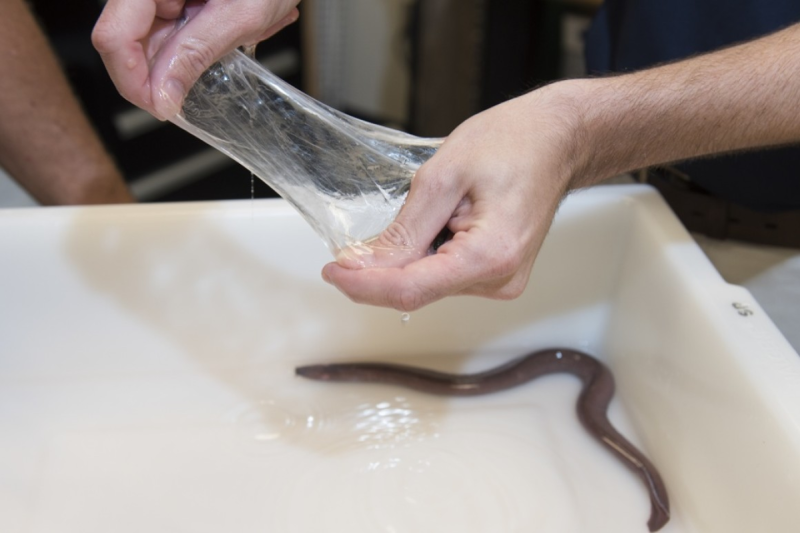In the cold, dark recesses of ocean floors around the world, hagfish slither around like sea snakes, searching for food. When a hagfish finds a suitable carcass, it devours the dead fish in two different ways. As it burrows face-first through the tissue, eating with its jaw-less, tentacled mouth, the hagfish also absorbs nutrients through its skin.
Hagfish are not the unholy result of dumping toxic waste in the ocean. They’re one of the oldest creatures on Earth, having been around for more than 300 million years. How have they lasted this long?

These ancient creatures have no eyes, no backbones, and no scales. They are often misidentified as eel, and often called ‘slime eels’, but they are definitely fish. They just don’t look like conventional fish. In fact, when conventional, gill-faced fish come after hagfish, those guys are in for a surprise, because hagfish have a disgusting but ingenious defense mechanism.
Whenever hagfish are attacked or even just stressed by nearby fish or curious grabby humans, they immediately emit amazing amounts of mucus at an alarming rate. At the same time, the hagfish shoots out silky strands of protein that hold the slime together in a cohesive blob. Any predator that tries to bite down on one of these velvety frankfurters of the deep sea will find its mouth and gills covered in a wad of suffocating slime.
How is it that hagfish haven’t slimed themselves out of existence? Whenever they get get a taste of their own medicine, these boneless noodles quickly twist themselves into a pretzel. In the same motion, they use their paddle-shaped tails to squeegee off the slime.
Silky, Sustainable Slime
One of the most interesting things about hagfish slime is its composition. The structure of hagfish slime is 99.996% water, and it has some interesting properties that could lead to different kinds of sustainable resources. But that’s only if scientists are able to replicate it. Hagfish can’t really be farmed because they don’t breed in captivity. Not much is known about their reproductive habits at all.

Hagfish slime is made of two different kinds of protein. One is a type of mucin, which acts much like the mucus that the human body uses to drown bacteria and viral intruders in antibodies and enzymes.
The other protein is in the form of tiny threads that are 100 times thinner than human hairs. These strong and stretchy threads act a lot like spider silk. As soon as the hagfish releases the goods, the mucin absorbs water and the protein threads get entangled with each other, creating a soft, stretchy slime.
Researchers believe these threads could potentially replace fossil fuel-based products like nylon and other synthetic materials. The threads are ten times stronger than nylon, so they could potentially be used in bulletproof vests and other protective equipment.
These threads are so thin that they make hagfish slime one of the softest materials known to man. Your most comfortable t-shirt has nothing on a shirt made from hagfish threads. Hagfish active wear would be more than next level.
Because hagfish slime absorbs water so rapidly and thirstily, some scientists believe it could be used to make super hydrogels for everything from disposable diapers to tissue engineering. We like to imagine cars with hagfish slime airbags, or big bags of dehydrated hagfish slime being used to absorb floodwater. What else do you think this stuff could be used for?
Thread Management in Hagfish
At any given time, a hagfish has about 20,000 km of fibers inside its body, ready to go. This incredible feat of organization requires a pretty phenomenal storage method. Each thread grows inside its own cell, called a gland thread cell. It begins life as a wild, wiggly wisp wedged between the upper wall of its cell and a large nucleus that takes up most of the cell. As the thread matures and grows longer, it lays itself in neat vertical loops around the nucleus.

Over time the nucleus shrinks and stretches into a spike, settling at one end of the cell to act like a spindle. As the nucleus gets longer, so do the vertical loops of thread. A mature thread measures about six inches (15 cm) long, but it’s packed inside a cell that’s only about 1/10th of a millimeter long. All of this adaptation allows the cell to organize the 15-20 layers of thread into a single untangled skein that’s ready to spring forth and spread out into the slime.
For an ancient creature, the hagfish displays an incredible amount of biological precision. They are eaten as a delicacy in Korea, and their soft skin has been made into handbags and wallets since WWII. Elsewhere, they are largely ignored. As of 2011, the different hagfish species are facing various levels of endangerment. Hopefully, they won’t slip out of our hands entirely before we can figure out their secrets.

















The inspiration for Slimer.
And before we know it, Hagfish are hunted/collected to extinction, without first figuring out how to breed them in captivity, or what role they have in their natural habitat, leading to potential ecosystem failure.
After all, we haven’t seen similar incidents happen before when Humanity has found something interesting to poke at.
Though, on a lighter note, this is indeed an interesting material with interesting properties.
“They are often misidentified as eel, and often called ‘slime eels’, but they are definitely fish.”
Eels are also fish.
tbh I thought that there being no self-consistent definition of fish was a famous taxonomy conundrum, which a popular British trivia podcast takes its name from (No Such Thing as a Fish)
Generally, biologists talk about agnatha, “without jaws”, which are hagfish and lampreys; Chondrichthyes, which we probably would call fish, which includes sharks and rays, and a superclass Osteichthyes, which are definitely regarded as fish: salmon, perch, eels. Osteichthyes is the largest class of vertebrates by weight, number, and population. (This is to some extent a bogus stat: some modern biology classifications seem to consider everything with four appendages, like us and lizards, as subclasses within Osteichthyes, so by that definition, we’re more closely related to eels than eels are to hagfish.)
Well, I don’t have a biology background, so I will take you good folks at your word.
I’ve fished for American Eel, and they darn well resemble all of the other aquatic creatures I have fished for over the years, except relative body length.
That being said, there are many “eel-like” fish that are not eels (for example: knife fish such as the electric “eel”, various loaches, etc.). Taxonomically speaking, it must be tricky to figure out which is which without DNA analysis.
> “Hopefully, they won’t slip out of our hands entirely before we can figure out their secrets.”
Correction: “Hopefully, they won’t slip out of our hands.”
They shouldn’t be removed from existence regardless of what we can figure out.
Agreed!!
agreed by me as well
Hagfish are fished commercially off the Oregon coast – apparently they are a delicacy in Korea
There was an incident in southern Oregon a few years ago where a truck loaded with 7500 pounds of the things was in an accident and dumped its load all over the road. And all over some guys brand new Nissan.
The cleanup was described as “Lovecraftian”. No word on whether the Nissan survived.
https://www.oregonlive.com/pacific-northwest-news/2017/07/truck_full_of_eels_overturns_o.html
https://www.cnet.com/news/hagfish-spill-oregon-highway-101-slime-eels/
– Thanks for sharing, that was pretty entertaining.
This happened right in front of my grandmother’s house, in my tiny home town of Depoe Bay. Big news for such a small town.
“HagfishMan, HagfishMan does whatever a hagfish can,
Spins a slimy web anytime…”
[youtube https://www.youtube.com/watch?v=UV0-c_l_rZ4&w=560&h=315%5D
Why have they been around for 300 million years, if somebody shot a huge wad of sticky snot at you wouldn’t you leave it alone?
Explains how children have lasted so long.
That’s odd. Where I come from children don’t even last a couple decades.
They’re like Mayflies, individuals don’t last long but they show up every year.
“Get your hagfish-slime underwhere here!”
Or outdoor gear. “I swear a bear jumped me, tore off my raincoat and started rolling on it before eating it!”
I’ve owned a few “eelskin” wallets made from hagfish. Thankfully there was no slime, but there has been a popular myth that the “eelskin” has magical abilities to erase credit cards. I also have a lovely stainless steel mesh wallet (purchased long before credit cards had NFC capability) that was marketed ostensibly to keep “hackers” from reading the magnetic stripes on the cards remotely.
Depends on the eel species. Everyone knows that it’s the _electric_ eels that erase credit cards.
Somehow. After they’re dead, skinned, and turned into a wallet.
It’d be interesting to have hagfish protein strand emitters working alongside 3D printer hotends, if the hagfish protein strands were able to provide strength on the vertical axis.
Can’t see the benefit over a spool of common cotton or silk – Should work similarly well there, as you are just having to solve the problem of getting it to bond between layers. I had the idea that thin cotton wicking appropriate solvent could be extruded over infill layers into the voids so gravity and the solvent combine to melt the strands into multiple layers.. Not tried it yet, pretty much off the bottom of interesting ideas to try.
Might as well go UHMWPE if you’re going to use strands for reinforcement. It would probably be better if any strand material were able to be embedded in many orientations as compared to just vertical or horizontal, but that poses technical problems of it’s own. Maybe in a UV cured resin bath?
Iindeed, reason I was thinking of adding vertical ties is it seems like it should be a trivial engineering challenge. If it will do much good is unknown.
The other simplistic options is to print a good few layers of shell with infill voided so a resin can flow -By having a deliberate entrance to pour into the infill pattern and voids to let it flow freely internally should be able to slush cast the inside. But I expect the number of patches you would have to do on overhangs in particular so the resin can’t pour out too freely would drive you mad.
In short I think if you are needing such strength you are resorting to that just go full resin cast mode and print the master, make a good mould and fill with glassfibre (matt or loose wool) and resin. Or Print and metal cast etc.. There comes a point when trying to reinforcing a FDM print makes no sense.
Where can I buy some?
Try a local Korean grocery?